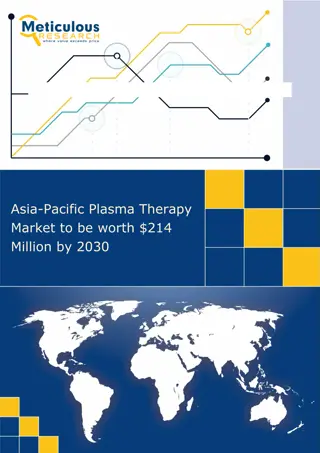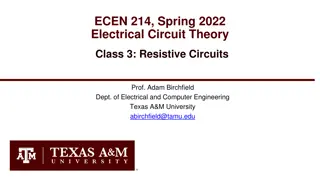
Understanding Malaria: Diagnosis, Treatment, and Pathophysiology
Explore the comprehensive aspects of malaria including laboratory diagnosis, treatment, prevention, clinical features, and pathophysiology. Learn about the prepatent period, clinical manifestations, and the impact of malaria on red blood cells leading to anemia.
Download Presentation

Please find below an Image/Link to download the presentation.
The content on the website is provided AS IS for your information and personal use only. It may not be sold, licensed, or shared on other websites without obtaining consent from the author. If you encounter any issues during the download, it is possible that the publisher has removed the file from their server.
You are allowed to download the files provided on this website for personal or commercial use, subject to the condition that they are used lawfully. All files are the property of their respective owners.
The content on the website is provided AS IS for your information and personal use only. It may not be sold, licensed, or shared on other websites without obtaining consent from the author.
E N D
Presentation Transcript
Objectives At the end of the session, Phase II MBBS students must be able to: Discuss laboratory diagnosis of malaria Describe treatment and prevention of malaria
CLINICAL FEATURES & LAB DIAGNOSIS
Pathophysiology In RBCs, merozoites mature to trophozoites & schizonts Schizonts rupture & release merozoites to invade other RBCs; continue erythrocytic cycle At the time of schizont rupture, release of malaria parasites & erythrocytic material into pathophysiology process of malaria & onset of symptoms blood circulation induces Activation of cytokine cascade is responsible for symptoms, signs of malaria
Prepatent period- interval from time of infection until parasites become detectable in the blood Incubation period (IP)- interval b/w infection & onset of symptoms IP depends on parasite species, transmission route, immune status, antimalarials, parasite density Species IP P. vivax 14 days P. falciparum 12 days P. malariae 28 days P. ovale 17 days
Clinical features Benign Malaria- Uncomplicated malaria; triad of febrile paroxysms, anemia & splenomegaly 1. Febrile paroxysms- Periodic bouts of fever, 3 successive stages- cold stage (15- 60 min): intense cold, uncontrollable shivering f/b hot stage (2- 6 hrs): temp 41 C f/b sweating stage: patient drenched in profuse sweat, temp drops rapidly, patient usually falls into deep sleep
Febrile paroxysm synchronises with erythrocytic schizogony Periodicity is 48 hours in tertian malaria (in P. vivax, P. falciparum, P. ovale) and 72 hours in quartan malaria (in P. malariae) Quotidian periodicity, with fever occurring at 24 hour intervals may be due to mixed infection 7
Anemia patient develops normocytic normochromic anemia d/t: Parasite induced RBC destruction Splenic removal of both infected RBC & uninfected RBC coated with immune complexes Bone marrow suppression leading to decrease RBC production Increased fragility of RBCs
Splenomegaly: After a few weeks of febrile paroxysms, spleen gets enlarged & palpable d/t massive proliferation of macrophages that engulf parasitized and non-parasitized coated RBCs 9
Malignant Tertian Malaria: Falciparum malaria Pathogenesis Sequestration of parasites in blood vessels of deep visceral organs leading to blockage of vessels, congestion, hypoxia Cytoadherence- binding of ifnected RBCs to endothelial cells mediated by PfEMP-1 (falciparum erythrocyte membrane protein-1) PfEMP-1 helps in binding of infected RBCs to uninfected RBCs (rosetting)
Malignant Tertian Malaria Severe/ complicated malaria Defined as one or more of following, occurring in presence of P. falciparum asexual parasitaemia Impaired consciousness: Glasgow coma score < 11 in adults; multiple convulsions Acidosis: respiratory distress Hypoglycaemia: Blood glucose < 40 mg/dL Severe malarial anaemia: Hb 5 g/ dL Renal impairment
Jaundice Pulmonary oedema- saturation < 92% Significant bleeding Shock Hyperparasitaemia: P. falciparum parasitaemia > 10% Most of severe malaria complications occur in non immune subjects with falciparum malaria 12
1. Cerebral Malaria: m/c cause of death in malignant malaria Schizonts of P. falciparum secrete a protein which promote aggregation of infected RBCs to other non-infected RBCs & capillary endothelial cells causing capillary plugging of cerebral microvasculature, vascular occlusion, cerebral anoxia Diffuse convulsion symmetric encephalopathy with generalized Muscle hemorrhages, neurologic sequelae, repeated seizures, and coma tone, tendon reflexes are reduced, retinal 13
2. Blackwater fever: In patients, who have had previous infections & inadequate treatment with quinine Antibodies develop against parasitized & quininized RBCs With subsequent infection and quinine treatment, there is immune complex formation followed by complement mediated massive destruction of parasitized & non-parasitized RBCs, massive intravascular hemolysis, absorption of hemoglobin by renal tubules Bilious vomiting, prostration, passage of dark red or blackish urine (black water) (hemoglobinuria) 14
3. Algid Malaria: c/b peripheral circulatory failure, rapid thready pulse with low blood pressure, cold clammy skin severe abdominal pain, vomiting, diarrhea, profound shock 4. Septicemic malaria: c/b high continuous fever with dissemination of the parasite to various organs, leading to multiorgan failure Death occurs in 80% of the cases 5. Pernicious malaria: Blackwater fever, algid malaria & septicemic malaria 15
a. Demonstration of parasite by microscopy (Gold standard) Blood can be taken from ear lobe/ finger tip prick 2 types of peripheral blood smears: 1. Thin smears: single layer of red cells, ending in tongue shape used for detecting parasites, determining species 2. Thick smears: usually 3 drops of blood are spread over a small area (about 1-2 cm2) amount of blood in thin smear is about 1 1.5 L, thick smear it is 3 4 L 17
Stained by Romanowsky stains- Leishmans, Giemesa, Fields, or JSB stain (named after Jaswant Singh and Bhattacharjee) Thin film is examined first at the tail end, if parasites are found, no need for examining thick film If parasites not detected in thin film, then thick film is examined 200 oil immersion fields should be examined before a thick film is declared negative 18
Speciation of malaria parasite
Various morphological forms of Plasmodium vivax Thin blood smear showing different forms of Plasmodium vivax; (A) Ring form; (B) Amoeboid form; (C) Schizont; (D) Male gametocyte; (E) Female gametocyte
Morphological forms of other Plasmodium species Thin blood smear showing: (A) P. falciparum ring forms such as multiple rings (blue arrow), accole form (red arrow) and head phone-shaped ring form (black arrow); (B) Female gametocyte of P. falciparum
Morphology in Giemsa-stained thin smears P. vivax P. ovale P. malariae P. falciparum Size of infected cells Smaller to Normal Enlarged Enlarged Normal Schuffner s dot Jame s dots Ziemann s dot Maurer s dot Stippling Stages seen in peripheral blood All All All Ring & gametocytes Not seen in peripheral blood Schizont 12-24 8-12 6-12 Gametocyte Round or oval Round Round Crescent
Advantages & disadvantages of peripheral smear simple, rapid and cheap Labour requires personnel intensive experienced and Thick smear is 40 times more sensitive than thin smear, can detect as low parasites per L of blood as 5 10 Low sensitivity of thin films: detection limit of thin smear parasites per L of blood Quantification of parasitemia is >200 Thin smear is useful in speciation of malaria parasite
b. Quantitative Buffy Coat: consists of three steps: (1) concentration of blood by centrifugation (2) staining with acridine orange stain (3) examination under ultraviolet light source Interpretation: Acridine orange stains the nuclear DNA (parasitized RBCs) fluorescent brilliant green 25
Normal RBCs dont take up stain (as they are anucleated) Parasitized RBCs appear as brilliant green dots WBCs also take up stain Advantage: faster, more sensitive, quantification can be done Disadvantage: less specific, is expensive, speciation cannot be done 26
Comparison b/w peripheral smear and QBC test Peripheral smear QBC Cumbersome Easy Method Longer, 60 - 120 minutes Faster, 15 - 30 minutes Time 5 parasites/ l in thick film and 200 / l in thin film Claimed to be more sensitive, at least as good as a thick film Sensitivity Gold standard False positives, artifacts may be reported as positive by not-so- well-trained technicians Specificity Accurate, gold standard Not possible Species identification Inexpensive Costly equipment Cost Everywhere Limited Availability
c. Fluoroscence Microscopy: Fluoroscent dyes like acridine orange or benzothiocarboxy purine are used, which stain parasites in RBCs stained slide is examined under fluorescent microscope method is mainly used for mass screening in field laboratory 29
d. Rapid Antigen Detection Tests: Immunochromatographic method: 1. Detection of histidine rich protein-2 (HRP-2) Ag produced by asexual stages of P. falciparum expressed on surface of RBC 2. Detection of pLDH (parasite lactate dehydrogenase) produced by trophozoites and gametocytes of all plasmodium species 3. Aldolase: enzyme in glycosis pathway in malaria parasites; used as a panmalarial antigen target 30
Advantages: high sensitivity & specificity Disadvantages: cannot detect other 3 malaria species remains positive months after cure 31
Schematic diagram of rapid diagnostic test
Advantages and disadvantages of RDTs Simple to perform, do not need extra equipment or trained personnel can be performed within 10 minutes >90% sensitive parasites/ L pLDH is produced by viable parasites, used to monitor response for treatment Intensity of band is directly proportional to parasitemia & severity of disease Expensive Cannot differentiate between the nonfalciparum malaria species False positive bands appear in rheumatoid arthritis factor positive cases at >100
Peripheral Smear Rapid Diagnostic Tests Equipment Microscope Kit only Training TRAINED MICROSCOPIST 'Anyone with a little training' Test duration 20-60 minutes or more 5-30 minutes Detection threshold 5-10 parasites/ L of blood 100-500/ L for P. falciparum, higher for non-falciparum Species differentiation POSSIBLE Not possible Quantification Possible Not possible Disadvantages Availability limited Unpredictable efficiency, cross reactions Differentiation between sexual and asexual stages Possible Not possible
e. Culture: Used for preparation of malaria Ag Trager and Jensen (1976) described simple method for continuous culture of P. falciparum using RPMI 1640 medium (Roswell Park Memorial Institute)
f. Molecular Methods: Nested multiplex PCR targeting 18S rDNA: for detection of all five human malaria parasites detection limit of 10 to 100 copies/ L can also be used to detect drug resistant genes Real time PCR: useful for quantification and speciation of parasites LAMP assay
g. Serodiagnosis for detection of Antibodies Does not detect current infection, measures past exposure Antibodies persist even after clinical cure Government of India has banned use of antibody detection tests for malaria diagnosis Used mainly for sero-epidemiological survey, identify infected donors to prevent transfusion malaria tests used are indirect hemagglutination, IFA and ELISA 37
h. Other Tests Measurement of hemoglobin and PCV Total WBC and platelet count Measurement of blood glucose Coagulation tests Urine for free hemoglobin, if blackwater fever is suspected Blood urea and serum creatinine to monitor renal failure 38
Treatment Anti-malarial drugs are used: to eradicate the erythocytic cycle and clinical cure to eradicate the exoerythrocytic cycle in liver to prevent relapse to destroy gametocytes to prevent mosquito transmission and thereby reducing human reservoir to prevent infections in non-immune person visiting endemic areas 39
m/c used antimalarials are : Chloroquine/primaquine/ Quinine Amodiaquin Pyrimethamine Doxycycline Sulfadoxine proguanil Newer antimalarial like artemesinin, lumefantrine, mefloquine, halofantrin are now commonly used for multidrug resistant P. falciparum infections 40
Uncomplicated Malaria Positive P. vivax, P. ovale and P. malariae cases are treated with chloroquine 25 mg/kg divided over 3 days For prevention of relapse (in Vivax malaria), primaquine is given in a dose of 0.25 mg/kg daily for 14 days under supervision In c/o choloroquine resistance: Quinine is given in a dose of 600 mg 8 hourly for 7 days along with doxycycline 100 mg/day 41
Complicated (Falciparum) Malaria Artesunate x 3d + sulfadoxine- pyrimethamine (single dose, on day 1) + primaquine (single dose on day 2) In northeastern states- Artemether- lumefantrine x 3d + primaquine (single dose, on day 2) 42
Prophylaxis Malaria Vaccine On 6 October 2021, WHO recommended widespread use of the RTS,S malaria vaccine Vaccine targeting pre-erythrocytic stage- RTS, S/AS01 most successful malaria trial; started in 2005 in Africa by GlaxoSmithKline (GSK) Consists of PfCSP (circum-sporozoite protein of P. falciparum), hepatitis B surface antigen (HBsAg), combined with a chemical adjuvant (AS01) to boost the immune system response WHO recommends the RTS,S/AS01 malaria vaccine be used for the prevention of P. falciparum malaria in children living in regions with moderate to high transmission as defined by WHO. 43
1. For travelers visiting endemic areas, chemoprophylaxis provides effective protection (proguanil, chloroquin, or mefloquin weekly or doxycycline daily) 2. Antiadult measures: Residual spraying: spraying of indoor surfaces of house with residual insecticides eg. DDT, malathion Space Sprays are those where insecticidal formulation is sprayed into atmosphere in form of mist or fog to kill insects (pyrethrum extracts) Use of repellants, protective clothing, bed net, preferably impregnated with long acting repellant, mosquito coils, and screening of house 44
Anti-larval Measures: Larvicide: oiling the collection of standing water or dusting them with paris green/ mineral oil Source reduction: reduce mosquito breeding sites, include drainage or filling Biological larvicide: Gambusia affinis (fish) and Bacillus thuringiensis (bacteria) can be used to kill the mosquito larva. 45
Thank you 46













